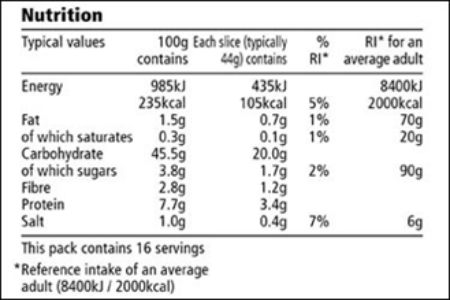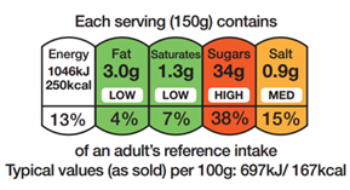Getting to understand food labels will help you make healthier choices when you shop.
You’ll be able to see at a glance if a food is high or low in salt, sugar, fat and energy, and compare products easily, helping to look after your blood pressure and your health overall.
What do nutrition labels tell you?
Most packaged foods are required by law to carry nutritional labelling on the packet.
The label will tell you how much energy (in kilocalories and kilojoules), fat, saturated fat (often written as saturates), carbohydrate, sugars, protein and salt is in the food. The amounts will be given per 100g or 100ml of the product, and sometimes by portion as well, so you can work out how much you’re eating.
You’ll usually find the label on the back of the packet, and it will look something like this one for sliced bread:

Traffic light labelling
Foods sometimes have a label on the front of the pack as well, which are often colour coded. Like this:

The colours tell you at a glance whether the food is high (red), medium (amber) or low (green) in fat, saturates (saturated fat), sugar and salt.
Use the colours as a guide to choosing healthier foods:
 A red light means this food is something you should limit. There’s no need to avoid it entirely, but go for smaller amounts or only eat it occasionally.
A red light means this food is something you should limit. There’s no need to avoid it entirely, but go for smaller amounts or only eat it occasionally.
 An amber light is fine most of the time, but you should try to go for foods with a green light for that nutrient at least some of the time.
An amber light is fine most of the time, but you should try to go for foods with a green light for that nutrient at least some of the time.
 A green light means the food is low in that nutrient. The more green lights a food has, the healthier it is.
A green light means the food is low in that nutrient. The more green lights a food has, the healthier it is.
When you go shopping, you will be buying many foods with a mix of green, amber and red lights. The best thing is to get the overall balance right by choosing as many greens and ambers as possible.
Understanding traffic light labels
Traffic light labels are color coded according to how much salt, fat or sugar they contain per 100g.
| Green - low A healthier choice | Amber - medium Generally fine to eat | Red - high Eat a limited amount of these | |
|---|---|---|---|
| Fat | Less than 3g | 3g - 17.5g | More than 17.5g (or 21g per portion) |
| Sugared fat | Less than 1.5g | 1.5g - 5g | More than 5g (or 6g per portion) |
| Total sugar | Less than 5g | 5g - 22.5g | More than 22.5g (or 27g per portion) |
| Salt | Less than 0.3g | 0.3g - 1.5g | More than 1.5g (or 1.8g per portion) |
How to choose healthier foods
A healthy blood pressure starts with a healthy shopping trolley. Check the labels for salt, saturated fat and sugar to look after your weight, your blood pressure and your heart. For controlling your blood pressure, salt is especially important, so go for as many green lights for salt as possible and aim to eat no more than 6g a day.
These practical tips will help you make the most of food labels and choose healthier options:
Give yourself more time for your next three shopping trips. At first, you will probably find that it takes a little longer than usual to do your shopping, as you look for the foods and brands that contain the lowest amount of salt, sugar and fats. But once you have discovered them, then your shopping trip shouldn’t take any longer than usual.
Break up your shopping trips into healthy shopping missions. To make it easier for yourself, use your next three shopping trips to discover the lowest salt, sugar and fat options for different foods:
- Week 1 – ketchups, sauces and stock cubes
- Week 2 – breads, biscuits and cakes
- Week 3 – snacks and other foods
Write a list of healthier products and brands you like and keep it with you. This will speed up your shopping once you have discovered the healthiest choices – but will be much healthier!
Avoid shopping on an empty stomach. Sticking to the list and not feeling hungry will help you avoid those impulse purchases.
Download our Free FoodSwitch app. It can help you make healthier choices when you're shopping. By scanning the barcode of a prodcut the app will tell you whether it is red, amber or green in salt, fats and sugar and suggest similar but healthier alternatives.
Learn more about salt and sodium on food labels and the foods that are high in salt, saturated fats and sugars.

